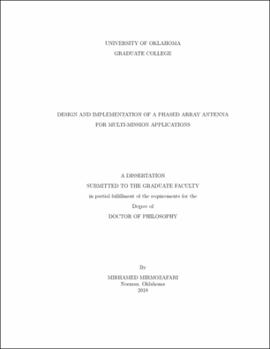| dc.contributor.advisor | Zhang, Guifu | |
| dc.contributor.author | Mirmozafari, Mirhamed | |
| dc.date.accessioned | 2018-05-11T19:48:02Z | |
| dc.date.available | 2018-05-11T19:48:02Z | |
| dc.date.issued | 2018 | |
| dc.identifier.uri | https://hdl.handle.net/11244/299910 | |
| dc.description.abstract | Multifunction Phased Array Radar (MPAR) was defined to investigate the
feasibility of integrating weather observation and air surveillance radars into
a single network. Weather radars require dual polarization capability which
may be also beneficial to aircraft characterization. Research activities have begun
to identify challenges, mitigate risk, and demonstrate polarimetric technologies.
Ten-panel, developed by MIT’s Lincoln Laboratory, was the first
dual-polarized planar phased array demonstrator. Alternatively, a cylindrical
polarimetric phased array radar (CPPAR) was developed at the Advanced
Radar Research Center of the University of Oklahoma to resolve the intrinsic
limitations of planar arrays in making accurate polarimetric measurements.
The current CPPAR employs a frequency scanning patch array antenna. Since
the radar’s performance would be the most important driver, the future operational
CPPAR, suitable for long-range weather measurement, will utilize a
new antenna with higher performance.
It is the purpose of this research to propose a new dual-polarized phased
array antenna for MPAR application. A crossed dipole antenna with sufficient
operational frequency bandwidth is designed. A high polarization purity is
achieved by using a group of efficient techniques in element scale. This element
was modified to obtain a higher match between copolar beams. The modified
element is utilized as an embedded element to form a cylindrical and a planar array antenna. It is demonstrated that suppressed azimuthal surface wave and
consequently highly matched copolar beams can be achieved in a cylindrical
array of proposed crossed dipole. In order to compensate for the electrical
and geometrical asymmetry of the element, an imaged arrangement of the
elements with respect to the center of the array is utilized. It is shown that a
planar array of the modified crossed dipole, arranged in a specific configuration,
proposes zero cross-polarization in the principal planes without increased side
lobe problem. The experimental verification demonstrates that the proposed
phased array antennas are promising candidates for multi-mission applications. | en_US |
| dc.language | en_US | en_US |
| dc.subject | Phased Array Antenna | en_US |
| dc.subject | Dual Polarization | en_US |
| dc.subject | Crossed Dipole | en_US |
| dc.subject | High Isolation | en_US |
| dc.title | DESIGN AND IMPLEMENTATION OF A PHASED ARRAY ANTENNA FOR MULTI-MISSION APPLICATIONS | en_US |
| dc.contributor.committeeMember | Hong, Yang | |
| dc.contributor.committeeMember | Doviak, Richard | |
| dc.contributor.committeeMember | Sigmarsson, Hjalti | |
| dc.contributor.committeeMember | Zhang, Yan | |
| dc.date.manuscript | 2018 | |
| dc.thesis.degree | Ph.D. | en_US |
| ou.group | College of Engineering::School of Electrical and Computer Engineering | en_US |
| shareok.orcid | 0000-0002-1151-2939 | en_US |
| shareok.nativefileaccess | restricted | en_US |
